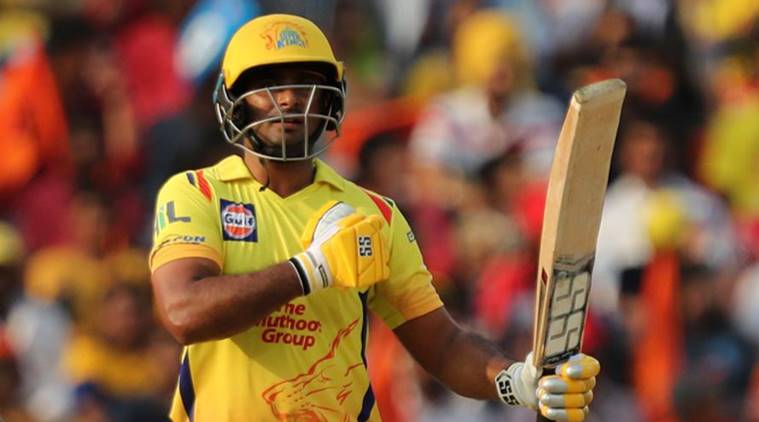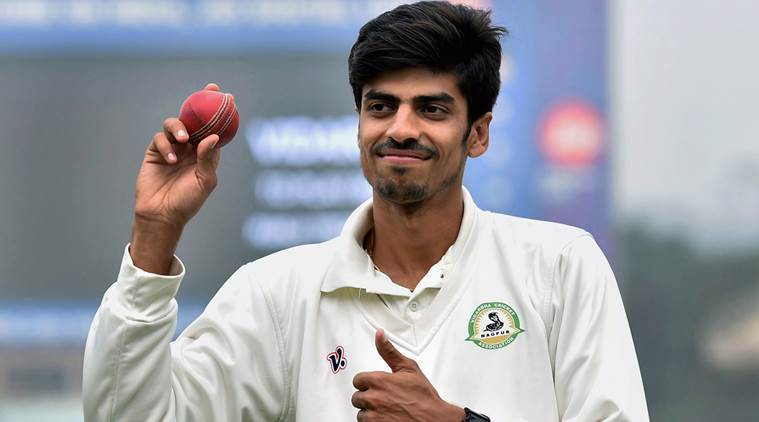 Ambati Rayudu is a rarity in modern day one-day cricket. (Source: File)
Ambati Rayudu is a rarity in modern day one-day cricket. (Source: File)
Rayudu rewarded
The ‘floater’ Ambati Rayudu doesn’t always get his credit, they say. He has played 34 ODIs, 20 of them coming in 2014, his most prolific year when he averaged 44.92 but despite a career average of 50.23, he hasn’t got a consistent run. The problem is this: As a middle-order batsman (from No 4 to No 7) he has averaged 34.71 from 23 games with 4 fifties. It isn’t bad but not necessarily slot-sealing exploits. Rayudu is a rarity in modern day one-day cricket. He usually bats down the order and plays solely as a specialist batsman. It’s a spot that is generally reserved for all-rounders or at least those pesky little batsmen who create an illusion that they can also bowl. Though he can bowl some harmless off-spin, Rayudu isn’t usually used by India. And while he has the big shots, he isn’t an explosive big-hitter in the traditional sense of the term, someone who can snatch the match in a relatively short period of time.
Another problem is that he is at his best in ODIs when pushed up the order. He averages 81.28, at No.3 position with 2 hundreds and 2 fifties from 11 games. At No.4, he averages 40.45 with 3 fifties from 12 games. But sending him at No. 3 would be the case of putting the individual over the team.They have the likes of Kohli for that slot and so, for the sake of team balance, he has batted lower down the order. Hardik Pandya has raised hopes recently but for a while before that, there was hardly any real allrounder who could bat at No 6 or 7. India tried Manish Pandey, Kedar Jadav and the likes to see if they can do the job in the lower order but Rayudu has come back into reckoning again.
With MS Dhoni rediscovering his big-hitting skills, and with Hardik hovering around, this might be a good phase for Rayudu as he doesn’t have to fill two gaps: as an all-rounder and as an explosive finisher.
Ranji winner Gurbani gets his big break
 A natural outswing bowler, Rajneesh Gurbani cracked open the Ranji Trophy final with a series of sharp nip-backers that surprised the opposition, but it’s something that he has been working on. (PTI)
A natural outswing bowler, Rajneesh Gurbani cracked open the Ranji Trophy final with a series of sharp nip-backers that surprised the opposition, but it’s something that he has been working on. (PTI)
Gurbani has always had to break the (bad) first impression. Even his long-time coach Prashant Bambal thought “hmm, he doesn’t even look like a fast bowler” when another coach brought Gurbani to his notice. Even in his engineering college, the physical education director Amit Anurag went. “He hardly looked like an athlete, and I thought, ‘chalo, lets see what he does’. It turned out that Gurbani wasn’t just a talented fast bowler but an excellent badminton player, good runner, and pretty good at tennis.
All doubts fade away when he runs in with the ball, and excels as he did in last Ranji season, taking Vidarbha to a Ranji title. A natural outswing bowler, he cracked open the final with a series of sharp nip-backers that surprised the opposition, but it’s something that he has been working on. Bambal tried to start the process a couple of years back, and it really hastened up at the guidance of Vidarbha’s bowling coach Subroto Banerjee. The result was there to see in the Ranji final when he harassed Delhi with a hattrick. The ball repeatedly darted back in, so much so that it was difficult to fathom that it’s a relatively new weapon in his repertoire. In an earlier game, he troubled Karun Nair with a slew of inswingers before he got one to move away to produce an edge.
He is still a work in progress though, and India A call-up can be a great step in honing him. The word from coaches, Bambal to Banerjee, is that he has to develop his upper-body strength, and that he still falls a bit after release. One thing, though, hasn’t been a surprise to anyone: his ambition to play for India. Once, couple of years back when Bambal was in serious chat with another bowler, Gurbani stormed in to interrupt: “Sir, You will train just one kid to become India player?”
Kaul adds mental muscle
 Siddarth Kaul has been working with Amit Bhattacharjee, who’s been a mentor to Olympic gold medalist Abhinav Bindra since over a decade.
Siddarth Kaul has been working with Amit Bhattacharjee, who’s been a mentor to Olympic gold medalist Abhinav Bindra since over a decade.
It’s not always you’ll hear about a fast bowler seeking the assistance of a mental trainer. Over the last year or so though, Siddarth Kaul has been working with Amit Bhattacharjee, who’s been a mentor to Olympic gold medalist Abhinav Bindra since over a decade. And so far in the IPL, he’s been very much on target whenever his captain’s thrown the ball to him.
In the build-up to the season, Kaul had admitted to feeling a lot “calmer” with his game in pressure situations thanks to having worked on his “breathing process” with Bhattacharjee. And it’s shown so far, as he’s by far been the best fast bowler in the death overs this season. While the likes of Sandeep Sharma and Jasprit Bumrah have slightly better overall economy rates, Kaul has gone at a staggering 6.8 in the last 4 overs throughout. Unlike Sharma, he rarely has had the luxury of bowling with the new-ball and has been Sunrisers’ go-to man every time they’ve been under the pump—which has been rather often considering the low scores they’ve left themselves to defend. He’s stepped up to the plate each time though, especially with Bhuvneshwar Kumar missing out in between owing to injury.
He’s wiry and not the tallest. But while he is handy with the new-ball, where he really comes to the fore is with his bullish temperament and the confidence to execute his variations when the margin for error is minimal. Take his contest against Hardik Pandya at Wankhede. Mumbai required 42 of 30 balls and a striker of Pandya’s quality at the crease. Kaul conceded only 8 runs in 2 overs, and snared three wickets including that of Pandya after not allowing him to get under even a single delivery. Kaul had made it to the ODI squad against Sri Lanka for the home series in December but ended up warming the bench.
Nair gets another chance
 It’s time Nair buries those ‘lazy’ perceptions as he still remains one of India’s better players against spin. (Source: PTI)
It’s time Nair buries those ‘lazy’ perceptions as he still remains one of India’s better players against spin. (Source: PTI)
To understand why Karun Nair is in the Test team one has to go back to the dramatic Bangalore Test against Australia last year. Indians were sucker punched by spin in the earlier Test, and again looked in some trouble. There was indecisiveness all round – whether to go forward or back, to play authoratively or defensively, to use the feet or not. The modern-day Indians have shown a certain vulnerability against quality spin, and hence the tentativeness wasn’t a surprise. One man stood out though for playing really different from the other Indians: Karun Nair seemed almost at ease out there against Nathan Lyon and co.
The central feature of his batting against spin is those wonderful skill with the hands. He was able not just tame but manipulate the turning ball – flicking, nurdling, and using his feet. He had the confidence, and hence the time to play spin without tentativeness.
The thing against Nair, though, came through in the same innings. Against the run of play, he got out, stepping out a touch early and allowing O’Keefe to take one away from him to get him stumped. This ‘against the run of play’ seems to be a thing with Nair.
But the talent, against spin in particular, is unmistakeable, and hopefully he has matured as a batsman to know how to make the good starts count. It won’t be easy if gets a chance against Afghanistan as he would run into a quality spinner like Rashid Khan, who foxed him with a googly in the IPL. There again, he had picked it, opened up his front foot to defend down the line but was beaten by the quickish turn. Seen live, it almost seemed a lazy defensive push – it’s time Nair buries those ‘lazy’ perceptions as he still remains one of India’s better players against spin.